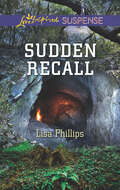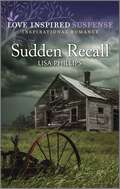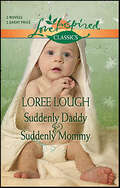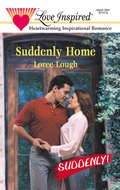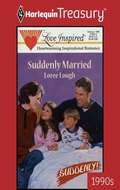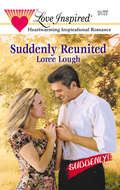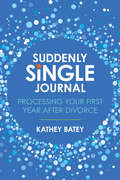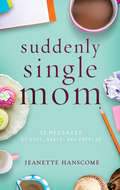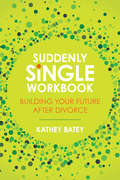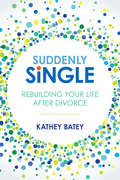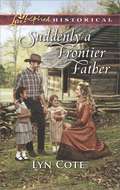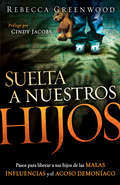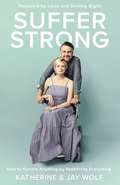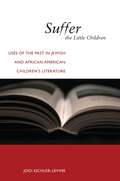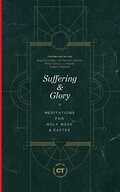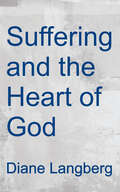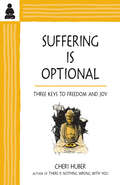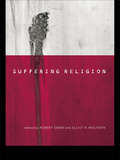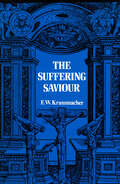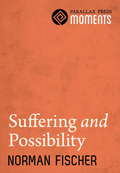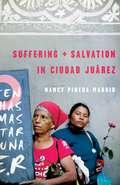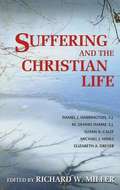- Table View
- List View
Sudden Recall: No One To Trust Mistaken Target Sudden Recall
by Lisa PhillipsDEADLY MEMORIES United States Marshal Jackson Parker never forgot Sienna Cartwright-but she's forgotten him. Just like she's forgotten everything she knew before she emerged from a coma a year ago. She has no memories of her career as a spy or any idea of what the CIA wants from her. And she certainly doesn't know why she's being hunted by men with military-grade weapons. As Sienna struggles to remember who she is and who she can trust, Jackson is determined to reconnect with the woman who broke his heart while protecting the woman she's capable of becoming.
Sudden Recall: No One To Trust Mistaken Target Sudden Recall
by Lisa PhillipsDEADLY MEMORIES United States Marshal Jackson Parker never forgot Sienna Cartwright—but she's forgotten him. Just like she's forgotten everything she knew before she emerged from a coma a year ago. She has no memories of her career as a spy or any idea of what the CIA wants from her. And she certainly doesn't know why she's being hunted by men with military-grade weapons. As Sienna struggles to remember who she is and who she can trust, Jackson is determined to reconnect with the woman who broke his heart while protecting the woman she's capable of becoming.
Suddenly Daddy & Suddenly Mommy
by Loree LoughStories of the blessings of parenthood from Loree LoughSuddenly DaddyCiara Dorsey's unsteady marriage to Mitch Mahoney is challenged by the FBI agent's seven-month assignment—especially when he gets the homecoming surprise of a lifetime. He's going to be a father! Can they mend their marriage for the baby's sake…and their own?Suddenly MommyThe precious baby in her care is a dream come true for Jaina Chandelle—but little Liam isn't hers to keep. She must unite orphaned Liam with his uncle, attorney Connor Buchanan. Both the baby and Connor need Jaina, if she's ready to accept that she's found the family she's always wanted.
Suddenly Home
by Loree LoughThere were times when Alex wanted to give up, but Taylor never gave him the chance. Body and faith bruised, Lieutenant Alex Van Buren had one wish -- to make it through another day. Then sprightly Taylor Griffith came into his life. and he began to wonder if it was time to face his future. Taylor had never known a man like Alex. The moment they met, she felt a connection. But the man stubbornly refused to let faith . . . or love . . . into his life. And if he didn't, how could she show him that with love and grace anything what possible?
Suddenly Married
by Loree LoughFinally a Bride - Teacher Dara Mackenzie loved kids with all her heart. Trouble was, she seemed destined to remain forever single, forever childless. Until two solemn, motherless tykes in her Sunday school class caught her eye, captured her heart -- and dragged her home to meet Daddy! Miraculously, blue-eyed widower Noah Lucas was the kind of man Dara had waited a long, lonely lifetime for. And the harried dad clearly wanted a woman around the house. So, before she knew it, Dara was a bride! But Dara knew that it took more to make a family. Now it was up to Noah to open his heart to Dara's love.
Suddenly Reunited
by Loree LoughFOR BETTER...Drew Cunningham had always been a man of strong faith. When he married Gabrielle, he knew he would love her forever-and she him.FOR WORSE...Now Drew's faith was being challenged. After less than a year of marriage, his beloved Gabrielle had left him, and he felt powerless to change things.AS LONG AS THEY BOTH SHALL LIVE?Who could have predicted the fateful accident that would wash away Gabrielle's memory? Suddenly Gabrielle believed they were still married, and Drew vowed not to waste this precious second chance. He would find the strenght to become the man his wife needed...and win back the woman who held his heart.
Suddenly Single Journal: Processing Your First Year after Divorce
by Kathey BateyThis guided journal empowers readers to set their own courses in the year of “firsts” after divorce, bringing their new lives into perspective as they record emotions, struggles, and triumphs. The twelve months after a divorce is a time of first milestones for a newly single person: first holidays, and first dinners alone with old friends, first solo financial decisions. These experiences add to the disorientation of the divorce experience. This Suddenly Single Journal guides readers through that first year with compassion. This is a place to vent, to plan, to hope. It is also a way to see God at work through a difficult season. As readers put their hearts into words, they will find that even in this painful time, beautiful possibilities begin to surface.
Suddenly Single Mom: 52 Messages of Hope, Grace, and Promise
by Jeanette HanscomeRaising your children alone may not have been your plan, but these 52 encouragements will support and inspire you to thrive in your new role.
Suddenly Single Workbook: Building Your Future after Divorce
by Kathey BateyThis hands-on workbook helps readers create new life plans and embrace their God-given purpose after the trauma of divorce. Beginning with a personal assessment, the Suddenly Single Workbook encourages readers to create and manage their new life after divorce in critical areas including finances, material and mental clutter, boundaries, social networks, smart risks, communication, and setting new goals. Expert Kathey Batey knows how powerful life transitions can be and how to make the most of them. She knows how the grief and anger of divorce can feel paralyzing and hopeless. Through Scripture, thought-provoking questions, and stories, Batey helps readers start the rest of their lives with resilience, hope, and determination.
Suddenly Single: Rebuilding Your Life after Divorce
by Kathey BateyThis compassionate guide through grief, fears, and the challenges of divorce encourages readers to see this painful time as potentially one of the most powerful. Kathey Batey understands the trauma of going through a divorce. In Suddenly Single, she guides readers who have experienced divorce in how to:Grieve the past and learn God has a future for them;Develop a network of experts for legal, financial, spiritual, and emotional needs;Navigate parenting decisions;Give structure and protection in fragmented relationships; andEmbrace God’s comfort in the midst of deep pain. Divorce is not the end of the story. Suddenly Single comes alongside readers to help them move forward into life a full of possibility.
Suddenly a Frontier Father
by Lyn CoteHis Ready-Made FamilyMason Chandler is home to meet his mail-order bride—six months too late! Little wonder Emma Jones wants to honor his letter releasing her from their agreement, especially when Mason has returned from his father’s deathbed with two adopted girls in tow. And the dark secret he’s hiding makes the homesteader feel unworthy to woo anyone. As the new schoolteacher in Pepin, Wisconsin, Emma can support herself without a husband. Yet she’s touched by Mason’s kindness to his half sister and her orphaned companion. Taking the little girls under her wing comes naturally to Emma—and they dearly want her for their mama. Can Mason break free of his past to fight for their surprise family?
Suddenly, Love
by Aharon AppelfeldA poignant, heartbreaking new work by "one of the best novelists alive" (Irving Howe)--the story of a lonely older man and his devoted young caretaker who transform each other's lives in ways they could never have imagined. Ernst is a gruff seventy-year-old Red Army veteran from Ukraine who landed, almost by accident, in Israel after World War II. A retired investment adviser, he lives alone (his first wife and baby daughter were killed by the Nazis; he divorced his shrewish second wife) and spends his time laboring over his unpublished novels. Irena, in her mid-thirties, is the unmarried daughter of Holocaust survivors who has been taking care of Ernst since his surgery two years earlier; she arrives every morning promptly at eight and usually leaves every afternoon at three. Quiet and shy, Irena is in awe of Ernst's intellect. And as the months pass, Ernst comes to depend on the gentle young woman who runs his house, listens to him read from his work, and occasionally offers a spirited commentary on it. But Ernst's writing gives him no satisfaction, and he is haunted by his godless, Communist past. His health, already poor, begins to deteriorate even further; he becomes mired in depression and seems to lose the will to live. But this is something Irena will not allow. As she becomes an increasingly important part of his life--moving into his home, encouraging him in his work, easing his pain--Ernst not only regains his sense of self and discovers the path through which his writing can flow but he also discovers, to his amazement, that Irena is in love with him. And, even more astonishing, he realizes that he is in love with her, too.From the Hardcover edition.
Suelta a Nuestros Hijos: Pasos para liberar a sus hijos de las malas influencias y el acoso demoníaco
by Rebecca Greenwood¡Libere a sus hijos del acoso demoníaco y enséñeles cómo mantenerse libres!No debemos asumir que nuestros hijos están exentos de las amenazas de las tinieblas. El propósito del enemigo es atrapar y cegar cada generación, al establecer fortalezas en la vida de nuestros niños desde temprana edad.Suelta a nuestros hijos es un manual para los padres, pastores y líderes, para ayudarlos a liberar a sus hijos de las influencias malignas y el acoso demoníaco. Lleno de historias de jóvenes que han sido liberados, explica la necesidad del ministerio de liberación para los niños y discute muchos asuntos que enfrentan en el mundo de hoy. Aprenderá cómo: •Determinar si un espíritu maligno está acosando a un niño •Lidiar con las influencias y el acoso demoníaco cuando se esté llevando a cabo •Adiestrar a los niños a identificar actividades demoníacas y a eliminarlas de sus vidas La oscuridad está en aumento y es el rol de los padres, pastores y otros creyentes hacer todo lo que esté a su alcance para asegurar que esta generación sea bendecida, protegida y liberada, de manera que puedan alcanzar su máximo potencial.
Suffer Strong: How to Survive Anything by Redefining Everything
by Jay Wolf Katherine WolfIs it possible to embrace suffering as a privilege, rather than a punishment? Beloved authors Katherine and Jay Wolf offer readers the bold invitation to trust a known God with an unknown future, as well as practical insights into surviving anything by redefining how we think about everything.After miraculously surviving a near-fatal brainstem stroke at age 26, as told in their memoir, Hope Heals, life for Katherine and Jay Wolf changed forever - and so did the way they viewed God, the world, and themselves in it. There was no going back to normal after such a tragedy. Yet Katherine and Jay learned that suffering is not the end, but rather the beginning of a new story. In Suffer Strong, they invite us into this new story as they share universal lessons and helpful practices that will help us to:Recognize we are being equipped for an uncommon assignment, not cursed by our story.Transform our unmet expectations into brave anticipations.Disrupt the myth that joy can only be found in a pain-free life.Rewrite the narrative of hard circumstances by turning our definitions of suffering into declarations of strength.And, ultimately, thrive even in the lives we never imagined living.
Suffer the Little Children: Uses of the Past in Jewish and African American Children's Literature (North American Religions)
by Jodi Eichler-LevineExamines classic and contemporary Jewish and African American children’s literatureThrough close readings of selected titles published since 1945, Jodi Eichler-Levine analyzes what is at stake in portraying religious history for young people, particularly when the histories in question are traumatic ones. In the wake of the Holocaust and lynchings, of the Middle Passage and flight from Eastern Europe's pogroms, children’s literature provides diverse and complicated responses to the challenge of representing difficultcollective pasts.In reading the work of various prominent authors, including Maurice Sendak, Julius Lester, Jane Yolen, Sydney Taylor, and Virginia Hamilton, Eichler-Levine changes our understanding of North American religions. She illuminates how narratives of both suffering and nostalgia graft future citizens into ideals of American liberal democracy, and into religious communities that can be understood according to recognizable notions of reading, domestic respectability, and national sacrifice. If children are the idealized recipients of the past, what does it mean to tell tales of suffering to children, and can we imagine modes of memory that move past utopian notions of children as our future? Suffer the Little Children asks readers to alter their worldviews about children’s literature as an “innocent” enterprise, revisiting the genre in a darker and more unsettled light.
Suffering & Glory: Meditations for Holy Week and Easter (Best of Christianity Today)
by Christianity TodayReflections on the wonder of EasterSuffering & Glory recovers some of the best Holy Week and Easter articles from half a century of Christianity Today. Guiding readers from Palm Sunday to Pentecost and including contributions from Tish Harrison Warren, J. I. Packer, Nancy Guthrie, and Eugene Peterson, Suffering & Glory will remind readers of the beauty of Christ's death and resurrection.
Suffering And The Heart Of God: How Trauma Destroys And Christ Restores
by Diane LangbergWhen someone suffers through trauma, can healing happen? And, if yes, how does it happen? Dr. Diane Langberg tackles these complex and difficult questions with the insights she has gained through more than forty years of counseling those whose lives have been destroyed by trauma and abuse. Her answer carefully explained in Suffering and the Heart of God is Yes, what trauma destroys, Jesus can and does restore.
Suffering Is Optional: Three Keys to Freedom and Joy
by Cheri HuberSuffering Is Optional: Three Keys to Freedom and Joy centers around three basic aspects of Zen practice: pay attention, believe nothing, and don' t take anything personally. As ending suffering requires that one sees how suffering happens, the book urges readers to be willing to be quiet and pay attention to the process of suffering in an effort to see each moment as an opportunity to step beyond illusion into freedom. It also argues that examining beliefs,abandoning them, and returning attention to the present is essential to ending suffering, as is living in the awareness that nothing in the universe is personal.
Suffering Religion
by Robert Gibbs Elliot R. WolfsonIn a diverse and innovative selection of new essays by cutting-edge theologians and philosophers, Suffering Religion examines one of the most primitive but challenging questions to define human experience - why do we suffer? As a theme uniting very different religious and cultural traditions, the problem of suffering addresses issues of passivity, the vulnerability of embodiment, the generosity of love and the complexity of gendered desire. Interdisciplinary studies bring different kinds of interpretations to meet and enrich each other. Can the notion of goodness retain meaning in the face of real affliction, or is pain itself in conflict with meaning?Themes covered include:*philosophy's own failure to treat suffering seriously, with special reference to the Jewish tradition*Martin Buber's celebrated interpretations of scriptural suffering*suffering in Kristevan psychoanalysis, focusing on the Christian theology of the cross*the pain of childbirth in a home setting as a religiously significant choice*Gods primal suffering in the kabbalistic tradition*Incarnation as a gracious willingness to suffer.
Suffering Saviour
by F KrummacherThe Suffering Saviour is a series of meditations on the events of Holy Week. This rich volume on the sufferings and death of Christ is one of the great devotional classics of all time. Its dramatized discourses interpret and portray the events of the last days of our Lord. The vividness and beauty of Krummacher's style, together with his crystal-clear simplicity, make this volume entirely free from theological verbiage, and suit it for the average Christian. At the same time it is an incomparable source of teaching and preaching material for the advanced student of the Word of God. It throws brilliant new light on every detail of the last week of Christ's earthly ministry.
Suffering Saviour
by F KrummacherThe Suffering Saviour is a series of meditations on the events of Holy Week. This rich volume on the sufferings and death of Christ is one of the great devotional classics of all time. Its dramatized discourses interpret and portray the events of the last days of our Lord. The vividness and beauty of Krummacher's style, together with his crystal-clear simplicity, make this volume entirely free from theological verbiage, and suit it for the average Christian. At the same time it is an incomparable source of teaching and preaching material for the advanced student of the Word of God. It throws brilliant new light on every detail of the last week of Christ's earthly ministry.
Suffering and Hope: The Biblical Vision and the Human Predicament
by J. Christiaan BekerA scholarly exploration of the topic.
Suffering and Possibility
by Norman FischerSuffering and Possibility is part of the Parallax Press Moments series of short ebooks. It is a stand alone chapter from Solid Ground: Buddhist Wisdom for Difficult Times.
Suffering and Salvation in Ciudad Juarez
by Nancy Pineda-MadridSince 1993 more than six hundred girls and women have been brutally slain in Ciudad Juárez in internationally condemned violence for which no one has been arrested. Nancy Pineda-Madrid's powerful reflection on this destructive and dehumanizing violence, based on first-hand knowledge of the traumatic situation in Juárez, attempts to understand the cultural, economic, and even religious factors that feed the violence. She detects in the social suffering of the women there a yearning for release, justice, and healing in their quest for salvation through solidarity and community practices that resist rather than acquiesce to the violence.
Suffering and the Christian Life
by Richard W. MillerSuffering is an inescapable aspect of human experience, and one that raises many questions: Why do we suffer? Where is God in our suffering? Who is this God that allows us to suffer? Where is God's purpose in our suffering? While the negativity of suffering creates many quandaries, the Christian tradition has also viewed suffering in positive terms. Jesus' suffering has been seen as salvific; indeed, his followers are called to take up their cross and follow him. The contributors to this volume, all distinguished Catholic theologians, confront these problems, drawing on the wisdom of the scriptures, Christian doctrine, and contemporary experience to explore the problem of suffering and its meaning for the Christian life. Contributors: Daniel J. Harrington, S. J. ; M. Dennis Hamm, S. J. ; Susan A. Calef; Richard W. Miller; Michael J. Himes; Elizabeth A. Dreyer
